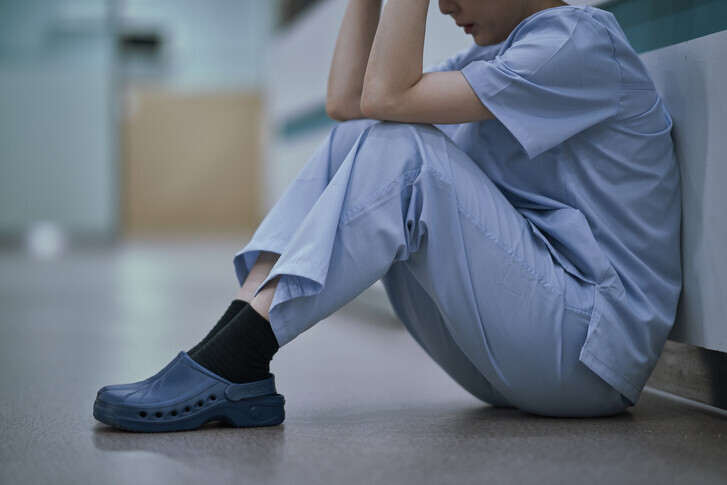hankyoreh
Links to other country sites 다른 나라 사이트 링크
Working women in S. Korea suffered 260,000 miscarriages over past 5 years

A nurse at a general hospital suffered a miscarriage this year. She applied for a legal guarantee of reduced working hours as soon as she found out she was pregnant. Her employer refused. She walked an average of 10,000 steps a day just in the hospital alone, and in the 8th week of pregnancy, she had a miscarriage. Her employer refused to issue her a leave of absence for her miscarriage.
From 2016 to 2020, 458,417 women had a miscarriage. Reflecting the lower number of pregnancies due to the low birth rate, the total number of miscarriages has decreased, yet the miscarriage rate has increased.
Of particular note, this rate was seen to be affected by the employment status of pregnant women. During this period, the rate of miscarriage was 7% higher for working women as opposed to those unemployed. This figure indicates that the working environment has a negative effect on pregnancies.
Although this number represents a large rise in the number of work-related accidents, only three miscarriages during this period out of a total of 258,646 were recognized as occupational injuries. The government has spent 46 trillion won (US$39,341,794,400) as of 2021 to counter the low national birth rate, yet it has neglected to protect pregnant workers and recognize miscarriage as a work-related accident.
The Hankyoreh received data from the National Health Insurance Service regarding the number of miscarriages and childbirth-related treatments from 2016 to 2020 through Rep. Chung Chun-suk, a member of the National Assembly Health and Welfare Committee. In each of the past five years, there was an average of 91,600 miscarriages. During the same period, an average of 262,700 women gave birth each year. One in four pregnant women had a miscarriage.
The total number of miscarriages has decreased as the total number of pregnancies has shrunk to reflect the low national birth rate. This decrease in miscarriages is nonetheless affected by whether or not a pregnant woman is working, as seen in a comparison of health insurance records for those employed to those not working.

From 2016 to 2020, the rate of miscarriage for unemployed women declined by 11,638 cases, or 25.6%, from 45,515 in 2016 to 33,877 in 2020. On the other hand, 52,101 employed females received medical treatment for a miscarriage in 2015 and 58,893 in 2020, representing no significant difference.
Among the total number of miscarriages, the miscarriage rate for working women rose from 53.4% to 60% during this period. This means that six out of 10 pregnant working women had a miscarriage.
The miscarriage rate difference between employed and non-employed women stands out. For the past five years, working women had 7% more miscarriages than those without jobs. By year, this miscarriage rate was 6.9% in 2016 — 27.2% for employed women, 20.3% for those non-employed, 7.1% in 2017 — 28.4%, 21.3%, 7.1% in 2018 — 30.2%, 23.1%, 7.1% in 2019 — 30.8%, 23.7%, and 6.8% in 2020 — 31.3%, 24.5%.
This disparity has been noted before. In 2016, the Korean Women's Development Institute analyzed miscarriage rates for working and non-working women from 2006 to 2015 and found a higher rate of miscarriage among working women in all age groups. The research team concluded, "It can be inferred that the work environment has a negative effect on pregnancy and childbirth."
Experts stress that in order to determine why working women suffer 7% more miscarriages than their non-working counterparts, several factors must be examined, such as the number of working hours, the type of work involved, and the presence of toxic substances in the workplace that could affect fetal development.
It is difficult to deny, however, the correlation between working and miscarriage.
Kim Sae-rom, director at Center for Gender and Health Research at the Citizen's Health Research Institute, said, "The continuously higher rates of miscarriage for employed versus non-working females is related to heavy workloads and intensifying workplace competition."
Choi Ye-hoon, an obstetrician-gynecologist, said, "It's generally known that overworking and shift work, or night shifts, are detrimental to maintaining a healthy pregnancy. To find the exact cause, more precise research is required."
By Choi Yoon-ah, staff reporter
Please direct comments or questions to [english@hani.co.kr]

Editorial・opinion
![[Guest essay] Preventing Korean Peninsula from becoming front line of new cold war [Guest essay] Preventing Korean Peninsula from becoming front line of new cold war](https://flexible.img.hani.co.kr/flexible/normal/500/300/imgdb/original/2024/0507/7217150679227807.jpg) [Guest essay] Preventing Korean Peninsula from becoming front line of new cold war
[Guest essay] Preventing Korean Peninsula from becoming front line of new cold war![[Column] The state is back — but is it in business? [Column] The state is back — but is it in business?](https://flexible.img.hani.co.kr/flexible/normal/500/300/imgdb/original/2024/0506/8217149564092725.jpg) [Column] The state is back — but is it in business?
[Column] The state is back — but is it in business?- [Column] Life on our Trisolaris
- [Editorial] Penalties for airing allegations against Korea’s first lady endanger free press
- [Editorial] Yoon must halt procurement of SM-3 interceptor missiles
- [Guest essay] Maybe Korea’s rapid population decline is an opportunity, not a crisis
- [Column] Can Yoon steer diplomacy with Russia, China back on track?
- [Column] Season 2 of special prosecutor probe may be coming to Korea soon
- [Column] Park Geun-hye déjà vu in Yoon Suk-yeol
- [Editorial] New weight of N. Korea’s nuclear threats makes dialogue all the more urgent
Most viewed articles
- 1[Guest essay] Preventing Korean Peninsula from becoming front line of new cold war
- 2Yoon’s broken-compass diplomacy is steering Korea into serving US, Japanese interests
- 360% of young Koreans see no need to have kids after marriage
- 4[Column] Why Korea’s hard right is fated to lose
- 5After 2 years in office, Yoon’s promises of fairness, common sense ring hollow
- 6S. Korean first lady likely to face questioning by prosecutors over Dior handbag scandal
- 7[Reporter’s notebook] In Min’s world, she’s the artist — and NewJeans is her art
- 8Film on 1948 Jeju Massacre wins prestigious prize at Sundance Film Festival
- 9[News analysis] Jo Song-gil’s defection and its potential impact on inter-Korean relations
- 10[Column] “Hoesik” as ritual of hierarchical obedience